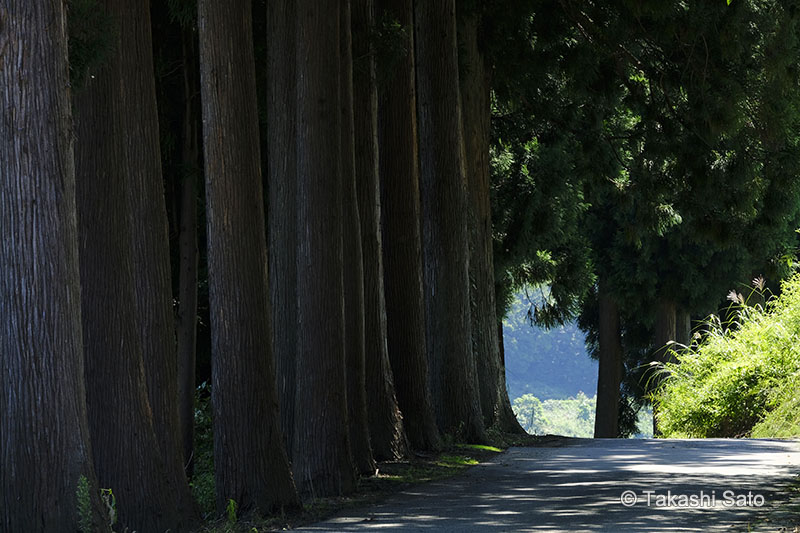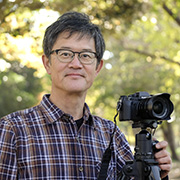Takashi Sato | Ball Head
Theme
Village scenery
Photographer
Takashi Sato
Date
September-November 2017
Location
Nigata, Fukushima, Yamagata, Mie
Device
Markins
:
FUJIFILM
:
X-T2
XF16-55mmF2.8 R LM WR
XF50-140mmF2.8 R LM OIS WR
XF100-400mmF4.5-5.6 R LM OIS WR
XF16-55mmF2.8 R LM WR
XF50-140mmF2.8 R LM OIS WR
XF100-400mmF4.5-5.6 R LM OIS WR
Velbon
:
GEO N730
Review
Takashi Sato
Member of the Japan Landscape Photographers Association
Born in Fukui Prefecture in 1963.
After graduating from Tokyo College of Photography in 1984, studied under mountain photographer Takehide Kazami.
In 1990, went freelance and continued to photograph rural and natural landscapes throughout Japan, with life's work focusing on Uonuma in Niigata Prefecture and the Minuma rice fields in Saitama Prefecture. In recent years, has been photographing nostalgic and relaxing landscapes of Japan's original past from all 47 prefectures. Work is mainly published in magazines, trade journals, calendars, etc. Also runs a photography workshop called "Sato Hotto" in hometown of Saitama Prefecture.
Member of the Japan Professional Photographers SocietyMember of the Japan Landscape Photographers Association
- Photo exhibitions -
2003
"Hometown of the Heart - Scenes of Echigo Uonuma" Pentax Forum
2011
"Hometown of the Heart - Photographing the Landscape of Uonuma" CoZA Room
2014
"Village Scenery" Fujifilm Square
2015
"Countryside Scenery" Fuji Photo Salon Nagoya/Fukuoka/Chofu/Sendai
2015
"In the Heart of Japan" Montreal Botanical Garden
2017
"47 My Detours: Exploring Japan Not in the Guidebook" Fujifilm Square
- Photo Collection -
"Hometown of the Heart - Photographing the Landscape of Uonuma" (Koubunsha)
"47 Satotabi" (Fukeisha Publishing)
Changes in shooting style
I have been a landscape photographer for many years. Many cameras have been released, and I have used various cameras to take pictures depending on the era.
When I became a freelancer, the first camera I started using was a 4x5 large format camera. My style is to take pictures of famous places and historical sites such as the sea, mountains, and cities one by one. I then started using a medium format camera, 645 size, and by effectively using zoom lenses, I have increased the variety of my work.
Then, about 10 years ago, just when digital cameras were starting to become popular, I started using 35mm small cameras as my main camera, and now I mainly use FUJIFILM's X series.
By switching from film to digital, the subjects of my photography expanded at once, and I began to pursue more shutter releases for various subjects. At the same time, I learned from my mistakes and started pointing my camera at anything.
In this way, my photography style changed dramatically when I switched from large and medium format cameras to 35mm size.
Next, a similar change occurred with the tripod head. The reason I switched to a ball head was because a photographer friend recommended it, but I was a little hesitant. That's because, even when I saw ball heads lined up in camera stores, I assumed that they were only meant to reduce the weight of equipment that is a burden when climbing mountains, and that there were no other advantages to using them.
However, when I actually tried using a ball head, I immediately realized that it was a good match for landscape photography. To operate it, first hold the camera in your right hand and the knob of the tripod head in your left hand, search for the composition with small movements, and when it's decided, tighten the large knob and release the shutter. That's it. There were no problems with the horizontal operation, which I was a little worried about.
I was able to search for the composition with intuitive movements, and my shooting style changed again.
When I became a freelancer, the first camera I started using was a 4x5 large format camera. My style is to take pictures of famous places and historical sites such as the sea, mountains, and cities one by one. I then started using a medium format camera, 645 size, and by effectively using zoom lenses, I have increased the variety of my work.
Then, about 10 years ago, just when digital cameras were starting to become popular, I started using 35mm small cameras as my main camera, and now I mainly use FUJIFILM's X series.
By switching from film to digital, the subjects of my photography expanded at once, and I began to pursue more shutter releases for various subjects. At the same time, I learned from my mistakes and started pointing my camera at anything.
In this way, my photography style changed dramatically when I switched from large and medium format cameras to 35mm size.
Next, a similar change occurred with the tripod head. The reason I switched to a ball head was because a photographer friend recommended it, but I was a little hesitant. That's because, even when I saw ball heads lined up in camera stores, I assumed that they were only meant to reduce the weight of equipment that is a burden when climbing mountains, and that there were no other advantages to using them.
However, when I actually tried using a ball head, I immediately realized that it was a good match for landscape photography. To operate it, first hold the camera in your right hand and the knob of the tripod head in your left hand, search for the composition with small movements, and when it's decided, tighten the large knob and release the shutter. That's it. There were no problems with the horizontal operation, which I was a little worried about.
I was able to search for the composition with intuitive movements, and my shooting style changed again.
Markins Ballhead
I have used ball heads from various manufacturers, but this time I tried the Markins, which was recommended to me because it is light and stops well.
Tighten the large knob that secures the ball and release the shutter. I think this mechanism is probably the same for all ball heads. With the Markins, you can simply tighten this knob lightly to secure the camera firmly, and it does not sag, but with the ball heads I have used in the past, this sagging has happened several times.
What's more, the Markins is light. If the head is heavy, the center of gravity will be shifted to one side when carrying the tripod, which will be a burden, so I am very happy with this lightness.
I also liked that the large knob that secures the ball and the small knob that secures the panning are located close to each other. When you want to move it slightly to the side, loosen the small knob and fine-tune the left and right. If you first align it to the horizontal, you can move it slightly left and right while keeping it horizontal with one hand. That's why I use it with the two knobs, large and small, positioned so that they are easy to operate with my left hand.
Tighten the large knob that secures the ball and release the shutter. I think this mechanism is probably the same for all ball heads. With the Markins, you can simply tighten this knob lightly to secure the camera firmly, and it does not sag, but with the ball heads I have used in the past, this sagging has happened several times.
What's more, the Markins is light. If the head is heavy, the center of gravity will be shifted to one side when carrying the tripod, which will be a burden, so I am very happy with this lightness.
I also liked that the large knob that secures the ball and the small knob that secures the panning are located close to each other. When you want to move it slightly to the side, loosen the small knob and fine-tune the left and right. If you first align it to the horizontal, you can move it slightly left and right while keeping it horizontal with one hand. That's why I use it with the two knobs, large and small, positioned so that they are easy to operate with my left hand.
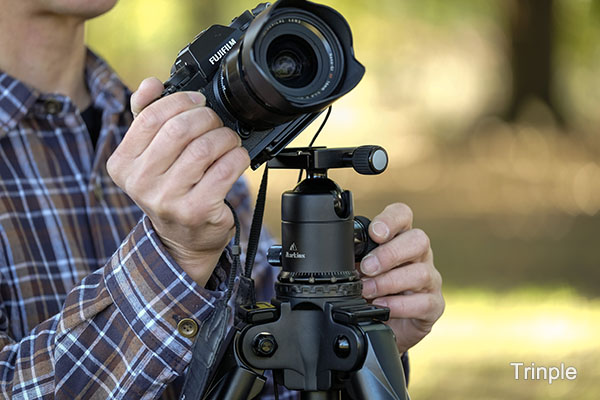
Arca-Swiss compatible
Markins is Arca-Swiss compatible, so I can use the X-T2 dedicated plate I already have from another company, but I decided to try using Markins' L-plate to match the tripod head. Markins' plate for X-T2 is a universal type that can be used with other cameras, so I was interested in how it would differ from the dedicated plate I had been using.
As for the L-plate, it is convenient because it can be quickly put into a vertical position and the optical axis does not change. This is a convenience that many users will definitely find useful, but there is another by-product. That is, it means that the number of vertical photos increases. Vertical photos also widen the field of view when shooting, which ultimately leads to improved work quality.
The Markins "PV-80 + LV-170 Universal L-Plate Set" that I used this time is a universal type, but it can be used firmly without shaking. However, because the size of the battery cover of the X-T2 does not fit over it, it is difficult to keep the distance between the body and the sub-plate, but since it is a general-purpose type, you just have to use it well. In my case, I use it in a vertical position by devising a way to attach it so that the release cable does not interfere as much as possible.
As for the L-plate, it is convenient because it can be quickly put into a vertical position and the optical axis does not change. This is a convenience that many users will definitely find useful, but there is another by-product. That is, it means that the number of vertical photos increases. Vertical photos also widen the field of view when shooting, which ultimately leads to improved work quality.
The Markins "PV-80 + LV-170 Universal L-Plate Set" that I used this time is a universal type, but it can be used firmly without shaking. However, because the size of the battery cover of the X-T2 does not fit over it, it is difficult to keep the distance between the body and the sub-plate, but since it is a general-purpose type, you just have to use it well. In my case, I use it in a vertical position by devising a way to attach it so that the release cable does not interfere as much as possible.
What was gained from the change?
Lightweight and compact cameras have helped me get closer to my subjects. That's why I feel like "people, plants, and scenery are smiling back at me." That's why I wanted a lightweight and compact tripod head.
The slimmer the equipment you carry, the easier it is to get closer to your subject. Cameras have changed from film to digital, and the cameras we use and our shooting styles have changed.
Of course, the tripod head has changed too. By using Markins, the tripod head has become lightweight and compact. These days, I feel like I've gotten even closer to my subject.
The slimmer the equipment you carry, the easier it is to get closer to your subject. Cameras have changed from film to digital, and the cameras we use and our shooting styles have changed.
Of course, the tripod head has changed too. By using Markins, the tripod head has become lightweight and compact. These days, I feel like I've gotten even closer to my subject.

● A morning in the rice fields (Kitakata City, Fukushima Prefecture)
FUJIFILM X-T2・XF50-140mmF2.8 R LM OIS WR
Aperture Priority AE(F14・1/340 s) -1.3EV ISO400 WB Clear sky
FUJIFILM X-T2・XF50-140mmF2.8 R LM OIS WR
Aperture Priority AE(F14・1/340 s) -1.3EV ISO400 WB Clear sky
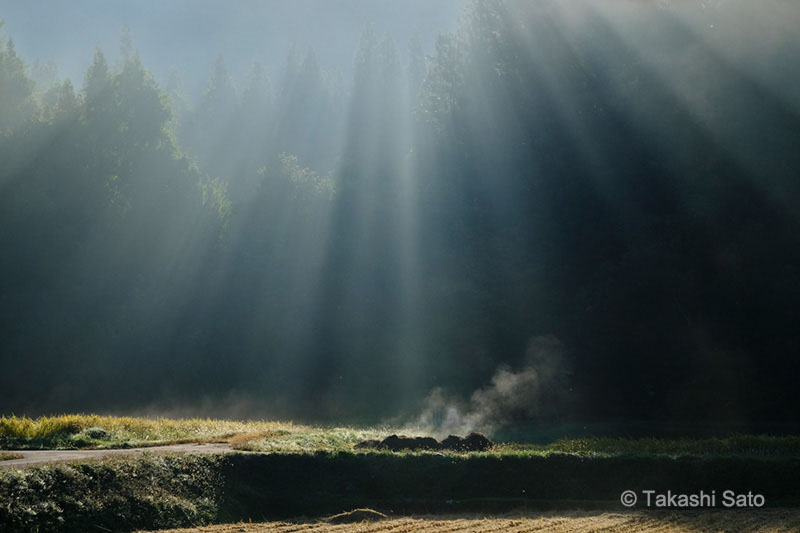
● A steel tower going up the mountain (Tadami Town, Fukushima Prefecture)
FUJIFILM X-T2・XF50-140mmF2.8 R LM OIS WR
Aperture Priority AE(F9・1/80 s) -1.7EV ISO200 WB Clear sky
FUJIFILM X-T2・XF50-140mmF2.8 R LM OIS WR
Aperture Priority AE(F9・1/80 s) -1.7EV ISO200 WB Clear sky
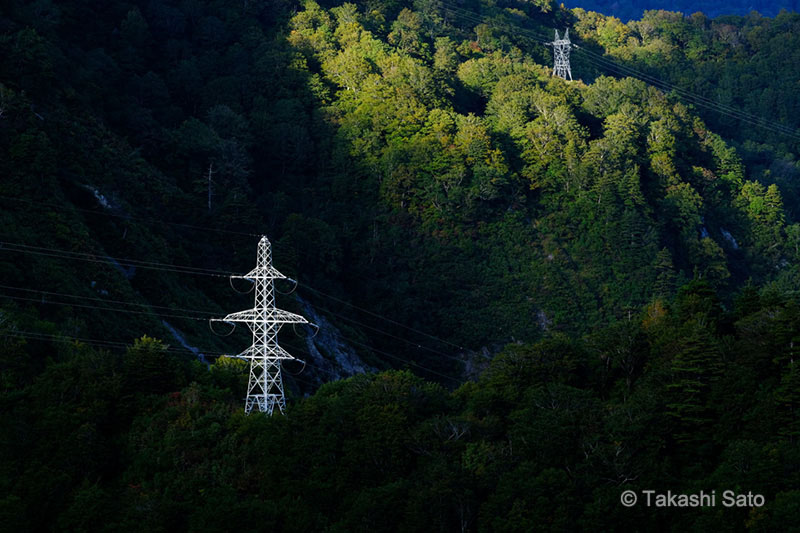
● Sky Observatory (Minamiuonuma City, Niigata Prefecture)
FUJIFILM X-T2・XF50-140mmF2.8 R LM OIS WR
Aperture Priority AE(F8・1/2400 s) +-0EV ISO400 WB Clear sky
FUJIFILM X-T2・XF50-140mmF2.8 R LM OIS WR
Aperture Priority AE(F8・1/2400 s) +-0EV ISO400 WB Clear sky
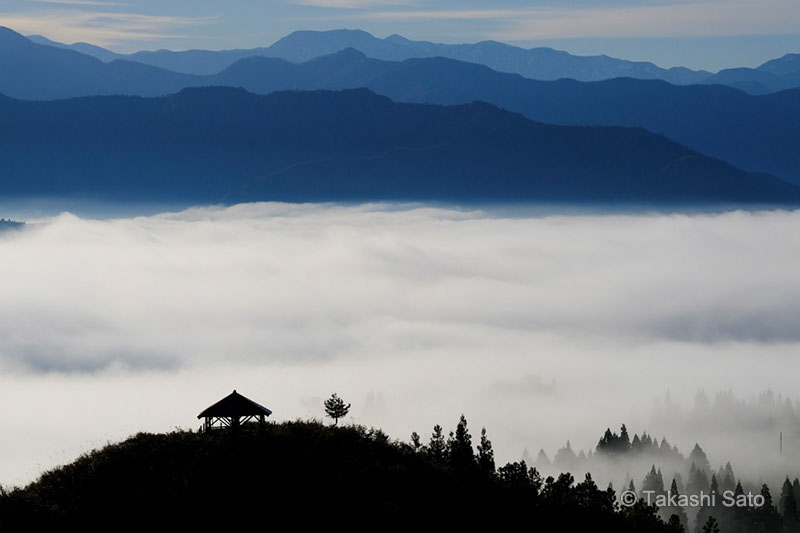
● Road leading to rice fields (Nagaoka City, Niigata Prefecture)
FUJIFILM X-T2・XF50-140mmF2.8 R LM OIS WR
Aperture Priority AE(F10・1/100 s) -2.3EV ISO400 WB Clear sky
FUJIFILM X-T2・XF50-140mmF2.8 R LM OIS WR
Aperture Priority AE(F10・1/100 s) -2.3EV ISO400 WB Clear sky
